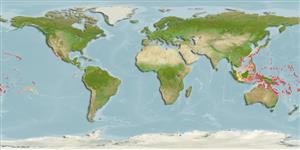Holothuroidea |
Holothuriida |
Holothuriidae
Environment: milieu / climate zone / depth range / distribution range
Ecology
Reef-associated; depth range 0 - 25 m (Ref. 122), usually 5 - 15 m (Ref. 104244). Tropical
Pacific Ocean.
Length at first maturity / Size / Weight / Age
Maturity: Lm ? range ? - ? cm Max length : 40.0 cm TL male/unsexed; (Ref. 122); common length : 30.0 cm TL male/unsexed; (Ref. 122); max. published weight: 500.00 g (Ref. 122); max. reported age: 6 years (Ref. 104241)
Body-wall thickness: 0.6 cm (Ref. 122). Color: blackish-brown (appearing black at depth) over entire body, dorsal surface textured, anus terminal, papillae sparse and short, anal teeth nodulous or serrated (Ref. 104244).
A poorly known species. Collected by divers for artisanal fisheries, but not intensively so, as it is found in lower densities and has a deeper distribution than other "blackfish" species. Processed product is not distinguished from those of other Actinopyga species; moderate commercial value. Occurs in moderately shallow water; never found on reef flats, but on flagstones of reef slopes (Ref. 122), particularly on sand on fore reef slopes (Ref. 85218). On coarse sand with coral rubble. Also found on semi-sheltered bay reefs with boulders and coral rubble; seldom on lagoon reefs or inshore reefs (Ref. 92930). Populations reach medium densities up to 0.1 per square meter. A poorly known species (Ref. 122).
Life cycle and mating behavior
Maturity | Reproduction | Spawning | Eggs | Fecundity | Larvae
Conand, C. 1998 Holothurians (sea cucumbers, Class Holothuroidea). p. 1157-1190. In Carpenter, K.E. and V.H. Niem (eds.) FAO Species Identification Guide for Fishery Purposes. The Living Marine Resources of the Western Central Pacific. Vol. 2. Cephalopods, crustaceans, holothurians and sharks. FAO Rome. (Ref. 122)
IUCN Red List Status
(Ref. 130435: Version 2025-1)
CITES status (Ref. 108899)
Not Evaluated
Not Evaluated
Threat to humans
Harmless
Human uses
Fisheries: commercial
| FishSource |
Tools
More information
Trophic EcologyFood items (preys)
Diet composition
Food consumption
Predators
Life cycleReproductionMaturityFecunditySpawningEggsEgg developmentLarvae PhysiologyOxygen consumption
Human RelatedStamps, coins, misc.
Internet sources
Estimates based on models
Preferred temperature
(Ref.
115969): 24.6 - 29.3, mean 28.3 (based on 1648 cells).
Fishing Vulnerability
Moderate vulnerability (36 of 100).
Price category
Unknown.
